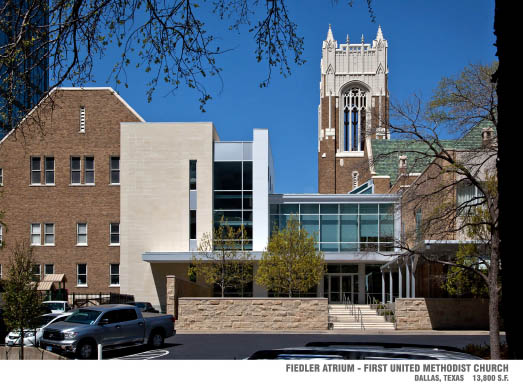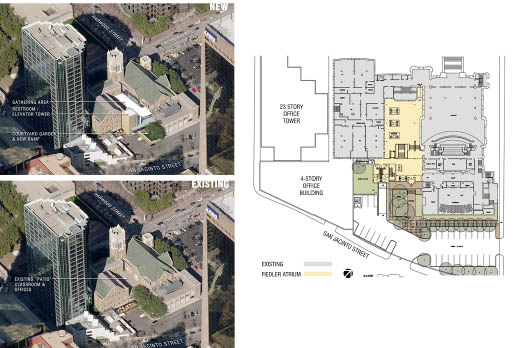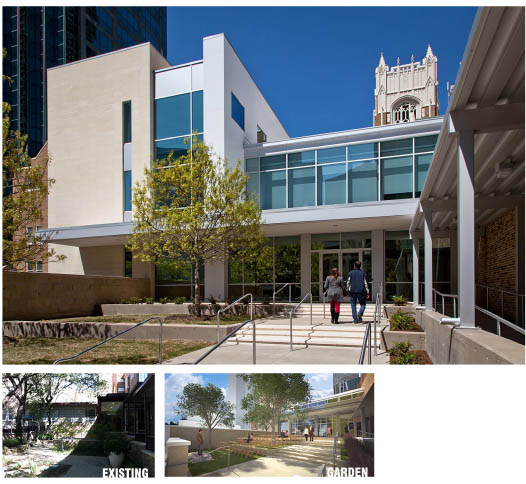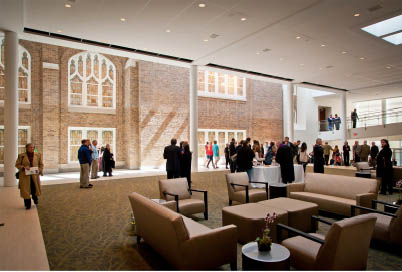
A new entry between the existing sanctuary to the right and an existing church support wing to the left. Photo by Nicholas McWhirter, AIA
By Nicholas McWhirter, AIA
My earliest memories of First United Methodist Church in downtown Dallas, Texas are veiled by the fog of nearly 30 years. Among these blurry vignettes from childhood memory is the experience of walking down a longish fluorescent-lit hallway and discovering a series of black and white photographs, hung in a line of mismatched frames. In a sort of sporadic time-lapse sequence, the images illustrated the construction of a church building in what appeared to be an open field: first appearing as just a hole in the ground, next a half-brick and half-steel skeleton, and finally a tall brick bell tower with steps leading down to a sidewalk and street, with what had to be Model-T cars parked alongside. The last image was marked with a date early in the year 1926.
If I had been standing in the same spot in 1926, the sun would have peeked through that neo-gothic bell tower on Ross Avenue and warmed my face. Even long-time members might have had a hard time believing that cramped corridor was originally the eastern edge of an open-air patio courtyard, an outdoor room that hosted Sunday afternoon fried chicken potlucks and wedding receptions under the stars. At some point in the late 1950s this central courtyard was filled in with a one-story addition, solving an immediate need for office and classroom space, but also putting that sad hallway into existence. None of this history would be obvious to a first-time visitor, but the stained-glass windows and painted brick wall across from the vintage photos were clues to the building’s layered past.

Plan and aerial showing before and after of the atrium’s placement.
Image courtesy of GFF Architects.
Laid out in a U-shaped footprint at the corner of Ross Avenue and Harwood Street, the First United Methodist Church of Dallas still stands proudly in buff brick, terra cotta details, green slate roof tiles, and gold leaded glass windows. When construction began in 1923, it was hailed as “The Million Dollar Church”—a fitting description given its scale and prominence in a neighborhood surrounded by low-slung mechanic shops and car lots. Three pairs of doors facing north toward Ross Avenue top a grand cut stone stairway that communicates “major entrance” in a universal architectural language. These doors lead to a formal narthex space at the rear of the sanctuary, one long bar of the U-shape. A connecting stairway and small classrooms originally formed the short bottom and the education wing made a three-story bar on the west side, parallel to the sanctuary. The south-facing patio court was that in-between space within the U-plan, providing light and air to the internal windows along both wings. Sadly, that 1950s remodeling project left both the western floor-level sanctuary windows and classrooms opposite them in the dark. All education wing openings were bricked-in and steep interior stairs were added to compensate for the rake of the sanctuary floor. Thus, the building’s accessibility problems were born as siblings to that tragic dark corridor.
The first major building expansion for FUMC Dallas was dedicated in 1964. Featuring an east-facing, two-story glass entry on Harwood Street called “Portals of Inspiration,” the annex added 22,000 square feet to the south end of the sanctuary, providing the congregation with desperately needed Sunday school classroom space, a choir room, theatre-in-the-round, and art gallery. It also radically changed the flow of foot traffic and the public entry sequence for the church. With a flat parking lot taking a full-city block to the east, and a few staff and visitor parking spaces on the remainder of the church’s land to the south, almost all pedestrian access into the church eventually took place from San Jacinto Street. The church’s back door became its de facto main entrance.
Despite its best intentions, the church still lacked several critical programmatic elements for any community of faith. It had no clear and welcoming public entry sequence leading to the heart of the campus for those coming by car (most people drive downtown from the suburbs, hence the FUMC catchphrase “The Difference is Worth the Distance!”). Lingering barriers for those with mobility challenges were in abundance. Original bathrooms with steps up to tiny water closets remained, and that sad, stair-riddled corridor continued to be the only internal route to bypass the sanctuary without interrupting worship services. By the beginning of 2011, it was time to work on a new master plan to envision the future for a growing downtown church serving a dramatically changing urban parish.

Entrance to the new atrium is accessed through a quiet garden space.
Photo by Nicholas McWhirter, AIA
A lay building committee was assembled to begin dreaming about what could be done to unify all building levels, provide accessible restrooms for every floor, and restore the central court to its original programmatic intent as a gathering space and central hub for the congregation. GFF Architects of Dallas was selected to work through the programming and technical complexities of the project, due to its experience in elegantly adapting and modernizing historic structures. The firm had recently transformed the 1920s former Parkland Hospital building into a high-end corporate office, carefully knitting glassy open workspaces between two antique brick wings.
Two major goals were established by the building committee and design team: First, restore the 1926 design intent of the patio by demolishing the cramped offices and hallway and transforming the area into a luminous community hub with a skylighted two-story atrium that delivers daylight to the sanctuary windows once again. Second, unify the various floor levels of both wings with a crisply detailed cast-stone and aluminum intervention, upgrading the dark, steeply sloped southern entry. The solution expanded the former patio south toward San Jacinto Street with a cast-stone tower element and terraced courtyard. The tower cleverly conceals two new elevators and accessible restrooms on each floor.

Entry lobby is a bright daylighted space with access to the church’s various spaces, with a new elevator to the left.
Photo by Nicholas McWhirter, AIA
Architecturally, the new San Jacinto elevation stands in delightful contrast as a foreground for the neo-Gothic character of the historic church building, while simultaneously harmonizing with the mid-century modern Crossroads Annex. As an entrance, the new façade presents an openness and transparency in alignment with the contemporary ministries of the 21st-century urban church. Eliminating barriers and constricted corridors is a meaningful reflection of the church’s values and mission in the world. The Fiedler Atrium stitches the two original brick wings together with a light touch, solving decades-old circulation challenges while giving the congregation a flexible central gathering space featuring the restored backdrop of the historic west sanctuary elevation.
Perhaps most important, this project put us on a path to dream even bigger about how our physical church building can be leveraged to serve an urban mission field in profound new ways. Around noon each Sunday morning, an inspired congregation departs FUMC Dallas through what was once a cluster of dark offices and narrow corridors, and is now a renewed, light-filled heart for the campus that propels them toward a world in desperate need of its grace and love.

New atrium space has become a community hub for the congregation and local neighborhood.
Photo by Nicholas McWhirter, AIA
AUTHOR NOTE
Nicholas McWhirter, AIA, with SHM Architects in Dallas, Texas, is Vice-Chair of the First United Methodist Church Dallas and a member of its Building Sub-Committee.
New atrium space has become a community hub for the congregation and local neighborhood. Photo by author
